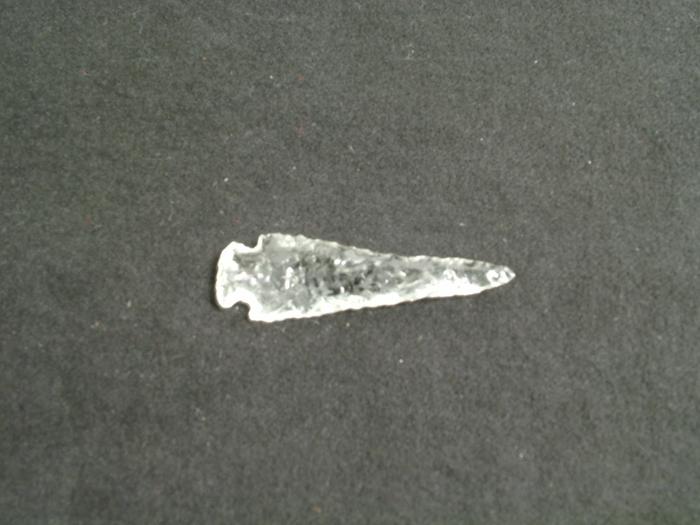Comments and Tags
Be the first to comment on this item!
Archaeology
Native American ➔ Arrowhead
Identifier:
113013UDescription:
A clear piece of beveled glass that has been flint knapped into an arrowhead. Created and knapped with a wooden instrument. Making the areas of the artifact where it has been worked smooth that has in turn due to the softness of the wood. With the absorbency of the wooden material the artifact is in turn very pristine and has crisp lines.Date:
1900 – 1910Materials:
Knapped, GlassCurrent Location Status:
In StorageCollection Tier:
Tier 2Source:
Gift Of Kendall, David WolcottRelated Entities:
Ernest Bowman (creator)Alternate names: Ernest Bauman
Ernest Bowman (Bauman), of Berlin, MI discovered an art of the ancients; he made arrowheads from flint and glass with the aid of only a stick. The 17-year-old protege of David W. Kendall puzzled every authority on ethnology and geology with his flint and glass arrowheads. He had rediscovered the art of flint knapping and could create these arrowheads with only a bit of wood. He died on March 27, 1906, at the age of 17. David Wolcott Kendall (donor)
David Wolcott Kendall, one of the early school of designers, was born October 11, 1851. He was a student, a musician, wood carver, artist, and inventor. He came to Grand Rapids from Indianapolis in 1877. He was colloquially named the "Dean of Furniture Designers." Kendall's widow, Helen Kendall, passed away in 1928, and willed it that the Kendall School of Art be created as a memorial to David. Kendall College of Art and Design remains a prominent art school in southwest Michigan.
David W. Kendall is famous for his McKinley chair, named after President McKinley, who owned one. By 1897, Kendall had the McKinley chair patented. While Kendall was influenced primarily by his European travels and ancient European art and design, he was an early and important advocate for the Arts and Crafts movement.
As a designer he served the William A. Berkey Furniture Company, the Phoenix Furniture Company and Berkey & Gay. His business sagacity and acumen became evident, and eventually he was made general manager of the Phoenix. Mr. Kendall is given credit for the development of antique oak, the sixteenth century, the canary, the cremona, and the malachite finishes, and many other features commonly employed in the modern method of furniture construction. He died February 16, 1910, in Mexico City, while on a tour of inspection and study of architecture and ornament of the prehistoric Incas, Toltec, and Mayan tribes of Yucatan and Central America. He also went to Egypt to study Egyptian ornament and hieroglyphics. Shortly before his death in Mexico he sent a rough pencil sketch of a settee to the factory, which was carefully detailed by William Balbach, his chief assistant.
